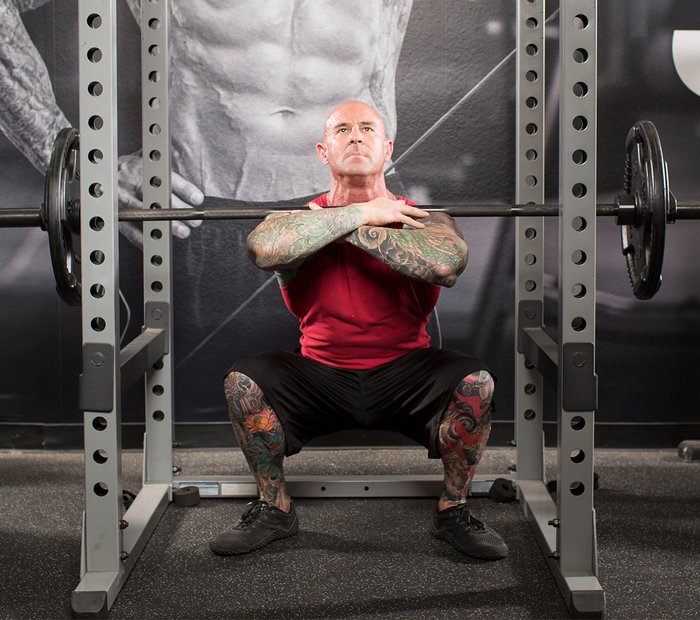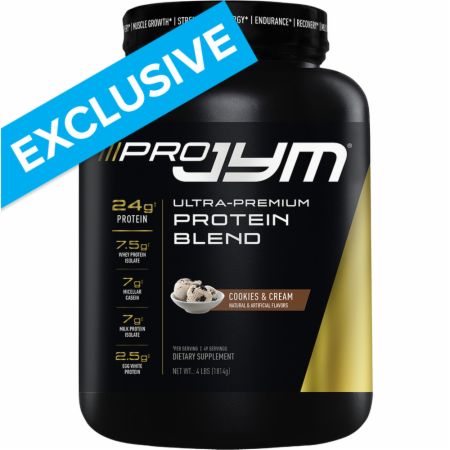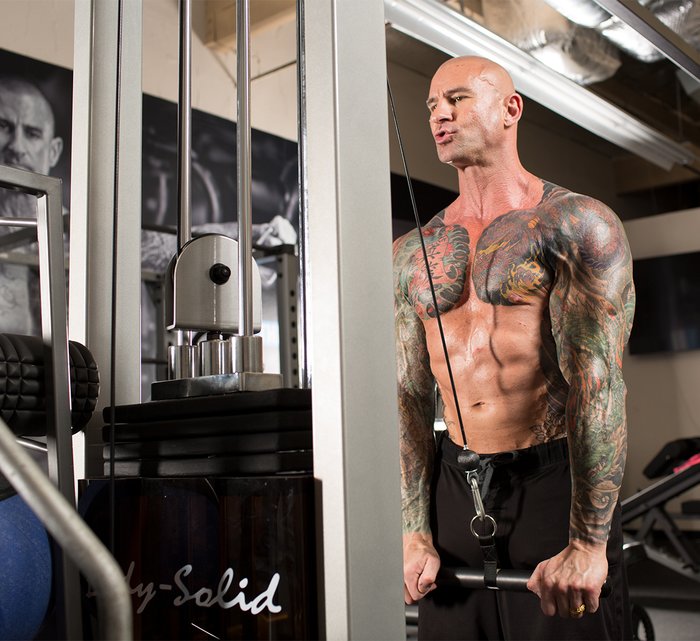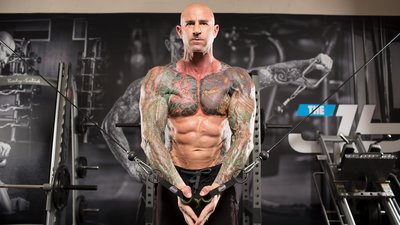As plateau-busting techniques go, few get the job done more efficiently than hundreds training. Got a muscle group that doesn't want to grow or a training program that's stagnant? Start addressing these issues and sparking new gains with just one set.
One set of 100 reps, that is.
Hundreds training has been around for a while, and it's about as simple as lifting gets. Just pick one exercise for a given muscle group, select a light weight, and do one all-out, grueling set of 100 reps. Body part complete! Now let it rest…and grow.
My approach to hundreds training adds a new, more aggressive spin on the technique: a whole-body approach, in every sense of the word. In my program, you'll work 10 individual body parts: chest, back, legs (quads and hamstrings), shoulders, traps, triceps, biceps, forearms, calves, and abs. You'll be giving each of these the 100-rep treatment, and you'll be doing so in four consecutive workouts.
If you're counting along at home, that's 1,000 total reps per workout. Times four.
At some point during your first Whole-Body Hundreds workout, you may think to yourself, "What did I get myself into?" You got yourself into a four-day program that will change your biochemistry, promote new muscle gains, burn fat, and strengthen your mind as much as it strengthens your body.
Hundreds of Benefits
The benefit of hundreds training lies in how it recruits the two major types of muscle fibers, slow-twitch and fast-twitch, through the course of each (long) set.
Because the weight is so light and the reps are so high, the slow-twitch fibers are worked thoroughly in the beginning of the set. Slow-twitch fibers are the ones used primarily for endurance-type activities, which is why high rep counts train them most effectively.

Fast-twitch muscle fibers, on the other hand, are utilized more during powerful activities: short, intense bouts of exercises such as sprints, heavy lifts, and plyometrics. Therefore, these types of fibers are best trained with either heavy weight and low reps or fast, explosive movements. However, once the slow-twitch fibers get gassed, the fast-twitch fibers come to their aid. One other important thing to remember here: Fast-twitch fibers have much more potential for growth than slow-twitch fibers.
Most muscles are around 50 percent slow-twitch and 50 percent fast-twitch, so it's a good idea to train both types of fibers regularly. Over the course of your 100-rep sets in this program, you'll be emphasizing the slow-twitch fibers on roughly the first 50 or so reps. At that point, those fibers will be fatigued and the fast-twitch fibers will take over to carry you the rest of the way.
This one-set journey to 100 can cause significant biochemical changes in the muscles. Specifically, it leads to greater growth of blood vessels that feed muscle fibers to enhance the delivery of oxygen, nutrients, and hormones to the cells.
Accompany this style of training with proper nutrient and supplementation. Of course, I recommend Pre JYM and Pro JYM before workouts and Post JYM and Pro JYM afterward. With 100 screaming reps and loads of nutrients, your muscles will have no choice but to grow bigger.

Hundreds Rundown
My Whole-Body Hundreds routine consists of four separate workouts performed on consecutive days, though you can feel free to insert a rest day or two if you like. In fact, I'll be posting on Facebook, Instagram, and Twitter the exact hundreds workouts I'm doing, starting tomorrow, August 4.
In each workout, you'll perform one set of 100 reps with a relatively light weight on 10 different exercises. That's one move per muscle group, in this order:
- Chest
- Back
- Legs
- Shoulders
- Traps
- Triceps
- Biceps
- Forearms
- Calves
- Abs
Just to be perfectly clear, I'm not talking about 100 consecutive reps without setting the weight down. Rather, each hundreds set will involve choosing a weight you can do for around 30 reps, then using the rest-pause technique to reach 100 reps.
Rest-pause is a pretty simple concept: Rep out to failure or close to it, then set the weight down and rest for 10-20 seconds. Pick it back up and continue repping out until reaching failure again, then rest another 10-20 seconds. Repeat in this manner until you reach 100 reps, however many rest-pauses it takes you to get there.

Each of the four workouts will be a little bit different, while still consisting of 10 exercises for 100 reps apiece. Here are specific directions for each of the individual routines:
Workout 1
Exercise Selection: Emphasize compound (multijoint) moves. (Think squat variations over leg extensions.)
Load: Pick a weight on each exercise that's approximately 50 percent of your 10-rep max or that has you reaching initial failure at around 30 reps.
Sets/Reps: After reaching failure or coming close to it, rest-pause until you reach 100 reps.
Workout 2
Exercise Selection: Emphasize single-joint (isolation) moves.
Load: Pick a weight on each exercise that's approximately 30 percent of your 10-rep max. (Think light!)
Sets/Reps: After reaching failure or coming close to it, rest-pause until you reach 100 reps.

Workout 3
Exercise Selection: Emphasize compound exercises.
Load: Pick a weight on each exercise that's approximately 30 percent of your 10-rep max.
Sets/Reps: After reaching failure or coming close to it, rest-pause until you reach 100 reps.
Workout 4
Exercise Selection: Emphasize single-joint moves.
Load: Pick a weight on each exercise that's approximately 50 percent of your 10-rep max.
Sets/Reps: After reaching failure or coming close to it, rest-pause until you reach 100 reps.
Want ideas for movements? I've got a full breakdown of multijoint and single-joint—or as I sometimes call them, "heavy" and "light"—movements in my Full-Body Giant Sets program.
Just pick your moves and do the work! There's not much to it, really—other than 1,000 reps per workout that will essentially exhaust every muscle fiber in your body!
My Whole-Body Hundreds workouts will be posted on my Facebook, Instagram, and Twitter pages. Enjoy your rest day, then enjoy the process of igniting new muscle-building gains through the sheer power of reps!
Visit JimStoppani.com for more workouts, training tips, and articles on nutrition and supplementation.

